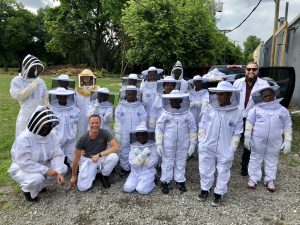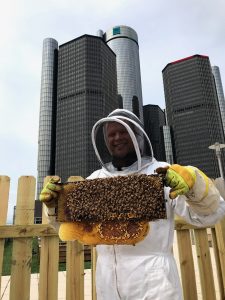Brian Peterson-Roest: Bringing Beekeeping into the Light

Brian Peterson-Roest of Bees in the D came into beekeeping as a hobbyist. A fifth grade teacher at Musson Elementary School in Rochester Hills, Michigan, Brian’s “call” to beekeeping literally came via a call. In 2008, he was asked as a public school teacher to participate in a free two-week crash course in beekeeping (taught through Oakland University) on Beaver Island on Lake Michigan. An award-winning math and science teacher, it was this opportunity and experience to learn with other teachers that “started my love for beekeeping,” he says.
Now Brian works at Bees in the D, a non-profit organization that works with Detroit and Southeast Michigan residents, schools and organizations on honey bee colony preservation and education.
Brian fell into beekeeping at a time of personal hardship in his life, and 10 years later, with the bee population being threatened by CCD, Brian feels it is his “obligation to now be a voice for them. And to help them in their hard time.”
With Bees in the D and a regional beekeepers club, Brian provides workshops, courses, and networking with other beekeepers. He also works with a company called Hive Tracks, which developed a software to compile data and reports for clients on the 160+ hives they’ve placed in 50 locations. The data is used to look at mite counts and the health of the beehives.
Through various modes of education, Brian enjoys working with urban youth and communities and helping dispel some stereotypes about bees in the process. He’s seen youth go from a place of not wanting to go near bees at all to a “point that I eventually get them in the suits,” says Brian. “I eventually get them near the hives and before you know it they are just thinking it’s the coolest thing.”
Brian has also found a need to educate building engineers and other adults in communities who often confuse nesting wasps with bees and assume an aggressive nature without distinguishing between the two.
With more knowledge and curiosity about bees spreading, beekeeping is “almost becoming trendy,” says Brian, which he doesn’t have a problem with as long as people do their homework. “I just don’t want people to misunderstand that you can’t just buy a hive, put bees in it and just expect it to just take care of itself. There is a lot that goes along with it.”

Brian recommends people interested in getting into beekeeping do a year of research to start. During that year, join a bee club, be part of a bee community and maybe find a mentor if you can. A lot of learning goes into the process but even with that, his own personal style is “minimalist.”
“I’m not going to go in the hives more than I have to because I want the bees to be able to do what they do,” says Brian.
Brian likes the direction that bee education is leading in with more and more people realizing the importance of bees – not just honey bees but also our native pollinators as well.
When he first started out in the business, he saw many beekeepers beekeeping in secret. “The hives were out of sight, out of mind.” There were many misconceptions. But now he feels “like beekeepers are kind of coming out of the dark because now people are starting to realize how important it is.”
Media Attributions
- Brian Peterson-Roest © Brian Peterson-Roest is licensed under a All Rights Reserved license
- Bees in the D © Brian Peterson-Roest is licensed under a All Rights Reserved license


Feedback/Errata